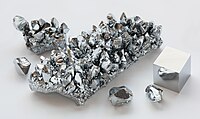
Photo from wikipedia
One-step separation and recovery of sodium, aluminum and iron in high-iron red mud in a high-calcium alkaline hydrothermal system is realized by a high-pressure hydrothermal reduction process. The transformation behavior… Click to show full abstract
One-step separation and recovery of sodium, aluminum and iron in high-iron red mud in a high-calcium alkaline hydrothermal system is realized by a high-pressure hydrothermal reduction process. The transformation behavior of the aluminasilica phase in high-iron red mud is mainly investigated. The results show that under the optimized conditions, a temperature of 290℃, a Na2O concentration of 240 g/L, a calcium to silicon ratio of 3.5, and a liquid–solid ratio of 5, the Na2O content in the transition slag is reduced to 0.12%, the dealkalization rate can reach 98%, and the alumina dissolution rate is 73%. When the starch-free reductant is added, the transition slag mainly consists of hematite and hydroandradite, and when the starch reductant is added (the addition amount is 1/4 that of ω(Fe2O3) in the red mud), all Fe2O3 in the transition slag is completely reduced to Fe3O4, and the main phases are magnetite and hydrogrossular.
Journal Title: Bulletin of Environmental Contamination and Toxicology
Year Published: 2022
Link to full text (if available)
Share on Social Media: Sign Up to like & get
recommendations!